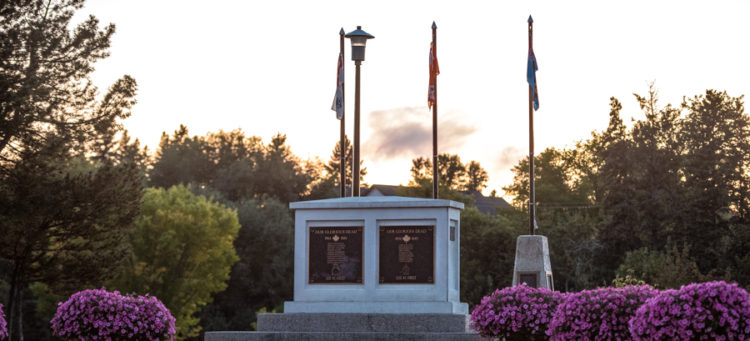
Meet You There
Cenotaph – St.Albert: Forgotten No More - The search for five soldiers missing from war records
October, 2019
During the First World War, a total of 10 men from St. Albert fell in the trenches, towns, fields, and forests of France and Belgium, where they have ever since been honoured at memorials and cemeteries across each country. Yet, for a century, five of those men’s ultimate sacrifices were somehow forgotten by their own hometown.
For nearly a decade, the names of Privates Moise Beausoleil, Wilfred Chevigny, Hector Duroche, Daniel Flynn, and William Laurence were all absent from the St. Albert Cenotaph on St. Anne Street. That’s where on Nov. 11, the annual Remembrance Day Ceremony is held, honouring the brave men and women who have served our country.
This mystery went unnoticed for years until 2012, when the Musée Héritage Museum began preparation for an exhibit that it would host two years later to commemorate the 100th anniversary of the beginning of what was then called The Great War. The exhibit, called Joining Up: Our Men and Women in the First World War, would include an honour wall of plaques providing information about every known soldier from St. Albert who had served in the war.
“I started looking at this in 2012 thinking ‘Okay, let’s try and figure out who our soldiers were,’” says museum curator Joanne White.
Soon, the museum’s education programmer, Roy Toomey, was on board too, helping White conduct research for the exhibit. This initially consisted of the two scouring through St. Albert’s main history book, The Black Robe’s Vision: A History of St. Albert and District, archived editions of The Edmonton Bulletin, Le courrier de l’ouest, and L’Union – three Edmonton newspapers – diaries, journals, and the cenotaph itself in order to find any information on local soldiers who had fought in that war.
The pair finalized a list of 80 men and one woman – a nursing sister named Margaret Kenned – from St. Albert who had enlisted in the First World War. The next phase involved entering each name into the First World War section of the Library and Archives Canada database in order to see which soldiers would appear. Once a soldier was found, the pair would check for a scanned version of his attestation papers to verify enlistment and whether that person had a legitimate connection to St. Albert.
“It was a decision about what those connections were and were they strong enough to say ‘This is a St. Albert resident,’” explains White.
Once the pair had determined which soldiers qualified as St. Albert residents, their final step was to insert each name into the Commonwealth War Graves Commission database to determine which St. Albert soldiers had indeed fallen in the war. Toomey and White had compiled a list of 10 fallen soldiers from St. Albert, five of whom were already on the local cenotaph – Privates Albert Goodman, Daniel and John Kennedy, and Clarence and Harry Maloney – and another five whose names were nowhere to be found.
“As we went through and kept finding more research, we were finding that this guy and this guy never came home,” says Toomey.
In 2015, the pair submitted a finalized folder to local legionnaires containing the names of 62 men and one woman from St. Albert – including those of the five fallen soldiers missing from the cenotaph – who had served in the First World War. And on September 11, 2016, a public ceremony was held at the cenotaph recognizing the names of all 10 fallen heroes.
There’s no solid answer regarding how those five soldiers wound up missing from the records, just a lot of speculation. One theory that White and Toomey are most confident in, is simply, time. Individual names of fallen soldiers were not added to the St. Albert Cenotaph until 2009, nearly a century after the end of the war. It’s also likely that the families of the confirmed war dead may have moved away over the years and weren’t available to verify the five that weren’t documented.
“A lot of information would have been lost in that time period. Soldiers parents would have passed on, and family would have moved away,” explains White.
To further complicate things, the cenotaph itself has been updated and relocated multiple times since its creation. With limited records, both the museum and the legion assume that the original cenotaph was erected sometime after the end of the Second World War, most likely coinciding with the founding of the Royal Canadian Legion St. Albert Branch in 1957. It was a cement cross approximately four feet high, located on the front lawn of the St. Albert Community Hall. In the mid-1960s, a new cenotaph was constructed on the corner of Sir Winston Churchill Avenue and Green Grove Drive.
However, due to noise from passing traffic, especially during each November’s moment of silence, the legion decided to once more relocate the cenotaph to its present location on St. Anne Street. This site was consecrated in the summer of 1987, with representatives present from the federal, provincial, and municipal governments, as well as dignitaries from the Royal Canadian Legion.
Today the cenotaph stands proudly on this same site, where it plays an important role in our community not only on Remembrance Day, but year round, by creating a greater overall understanding of St. Albert’s history and the heroism of its residents, regular men and women who acted bravely when called to duty. “I consider these men to be real heroes and I think it’s important that we don’t forget the sacrifices that two generations made in the name of Canada,” says Toomey.













